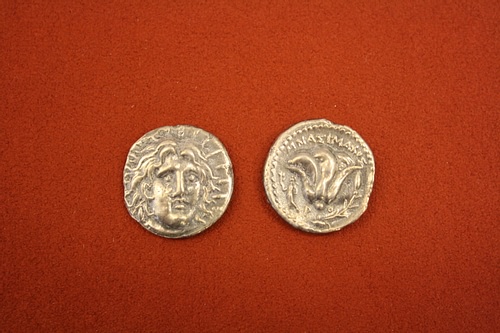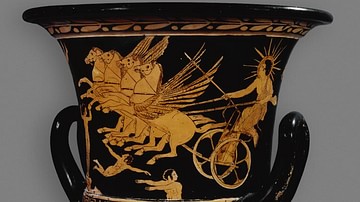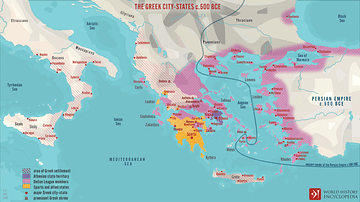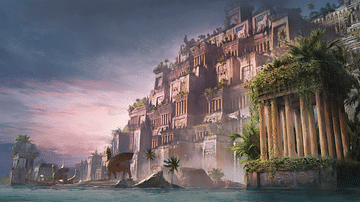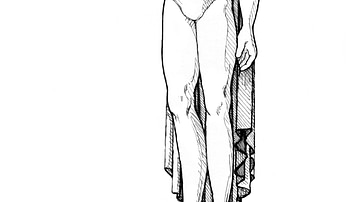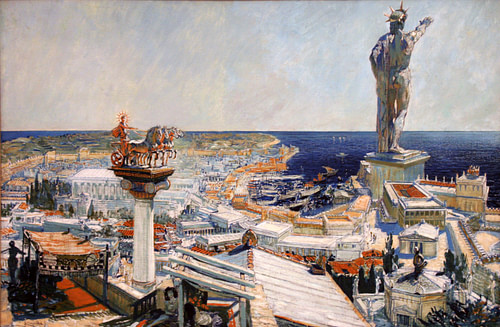
Rhodes, with an area of 1,400 km², is the largest island in the Greek Dodecanese group located in the south-eastern Aegean. The island was an important protagonist in wider Greek and Mediterranean affairs throughout the Bronze Age, Archaic, and Classical periods and was particularly prosperous in Hellenistic times. The island was also famed in antiquity as a cultural centre and for the Colossus of Rhodes statue, one of the Seven Wonders of the Ancient World.
Rhodes in Mythology
In Greek Mythology the name of the island derives from the nymph Rhodos who bore seven sons to the sun god Helios, the patron of the island. Three grandsons of these offspring were the heroes of the three principal cities on the island: Camirus, Ialysus, and Lindus, which were named after them. In honour of Helios, Panhellenic games, the Halieia, were held on the island every five years, and each year a chariot and four horses (quadriga) were thrown into the sea as an offering to the god (who was believed to ride such a chariot across the sky each day).
Other mythological associations with the islands include the belief that the Telchines had a workshop on the island. They were believed to be an ancient semi-divine race that invented and were particularly skilled at metalwork. Hercules was also worshipped on the island as the founder of the first settlement. Other important cults were dedicated to Apollo, Zeus, Athena, and Dionysos, and during the Hellenistic period, the island adopted several Egyptian cults such as those of Sarapis and Isis.
Historical Overview
The island was first inhabited in the Neolithic period, and the first concrete remains of early civilization are found at the prehistoric site of Trianda (Ialysos) on the north-west coast. The settlement became an important Bronze Age centre from the 16th century BCE, a period when the island was in close contact with the Minoan civilization based on Crete. The evidence for trade and cultural links with the Minoans includes finds of Cretan measuring weights, Linear A script, pottery, fresco design, and architecture.
Although Trianda was destroyed by earthquakes and buried in ash from the volcanic explosion of Thera in the late Bronze Age, the site was resettled by the Mycenaean civilization (based on mainland Greece). The Mycenaeans also established other colonies on the island from the 14th century BCE. The presence of Mycenaean culture is evidenced by pottery and rock-cut tombs, often arranged in rows and topped by large marker stones. The dedications found within such tombs and which include gold, silver, and glass objects, suggest a high degree of prosperity in this period. The presence of Egyptian scarabs and Cypriot seals attests to the extensive trade network the island had established and would cultivate over the next millennium.
Following extensive floods and the end of the Mycenaean period in the mid-11th century BCE, further Greek colonisation took place with the establishment of the tyrant-led city-states of Lindus (south-east), Ialysus (north), and Camirus (north-east). These poleis themselves created colonies, for example, Gela in Sicily and Phaselis in Lycia.
The island came under Persian rule in 490 BCE but in the later 5th century BCE, Rhodes became a member of the Delian League, led (and later to be dominated by) Athens. However, the island revolted against Athens in c. 412 BCE and sided with Sparta in the Peloponnesian War, an action which was followed c. 408 BCE by the city-states forming together to create a federal state, probably for greater commercial opportunities. The capital of the new state was Rhodes (Rhodos) at the northernmost point of the island.
Loyalty to Sparta ended in 395 BCE when democracy was established on the island. Briefly a member of the Second Athenian Confederacy c. 378 BCE, the island became subject to the Carian satrap Mausolus who stationed a garrison on the island in 357 BCE. The next foreign power to impose itself was Alexander the Great, who established a Macedonian garrison on the island; however, under his successors, Rhodes enjoyed another period of prosperity due to its five harbours and position near the newly established cities of the eastern Mediterranean. Demetrius I of Macedon attempted to take the island c. 305 BCE but was ultimately unsuccessful after a year-long siege. The entrepreneurial Rhodians sold Demetrius' siege equipment and used the proceeds to build a massive 33-metre high bronze statue of their patron god Helios - the Colossus of Rhodes and one of the Seven Wonders of the Ancient World. The statue, sculpted by Chares, a native of the island from Lindus, stood at the harbour entrance but was unfortunately toppled by an earthquake in 228 or 226 BCE.
The island remained independent and cultivated trade links, in particular, with the Ptolemaic Dynasty of Egypt. In addition, the naval fleet of Rhodes took on the important role of policing the Aegean against piracy, a problem of particular concern as islands such as Carpathos and Nisyros and the Peraea (an area of the eastern mainland) were now under the control of Rhodes.
Rhodes became an ally of Rome in the wars against Phillip V and Antiochus III and received as thanks territory in Caria and Lycia. However, not all Rhodians supported friendly relations with Rome and the alliance was not always a peaceful one. Things took a turn for the worse when Rhodes' dominant trade position was compromised by the Roman decision to make Delos, in the Cyclades, a free port in 167 BCE. Besieged by Mithridates VI in 88 BCE and sacked by Cassius Longinus in 43 BCE, the role of Rhodes as a major political force came to an end. However, the island did still enjoy a certain economic prosperity and it continued to hold a reputation as an important cultural centre, notably in sculpture and philosophy (especially the Stoics). Cicero also studied on Rhodes, continuing the island's literary tradition begun by one of its most famous sons, the writer and poet, Apollonius Rhodius.
The Archaeological Sites
Rhodes town, although extensively built upon in later periods, still shows the remains of temples, city walls, a stadium, odeum, and harbour constructions. Camirus never had a fortified acropolis; nevertheless, excavations have revealed a temple to Athena, stoas, an agora, and extensive private housing remains. Ialysus displays Mycenaean tombs, temples to Athena Polias and Zeus Polieus, and a fountain house.
Perhaps the most important archaeological site on the island is at Lindus, the capital before it was moved to Rhodes c. 408 BCE. A temple to Athena Lindia was built on the acropolis of the town, according to tradition, by Danaos in 1510 BCE. This was replaced with a new Doric temple in the 6th century BCE in the reign of the tyrant Cleoboulos. After this temple was destroyed by fire, another temple was rebuilt in 342 BCE. A large propylon or gate and a monumental stairway were added to the sacred site c. 300 BCE. In the 2nd century BCE, a Hellenistic stoa was constructed. Also of interest are the remains of the theatre which originally had 26 rows of seats and a capacity for some 18,000 spectators, a temple to Dionysos, and rock-cut tombs. All of these monuments are testimony to the wealth and prestige once enjoyed by the island from its role as a trade hub in the eastern Mediterranean.

